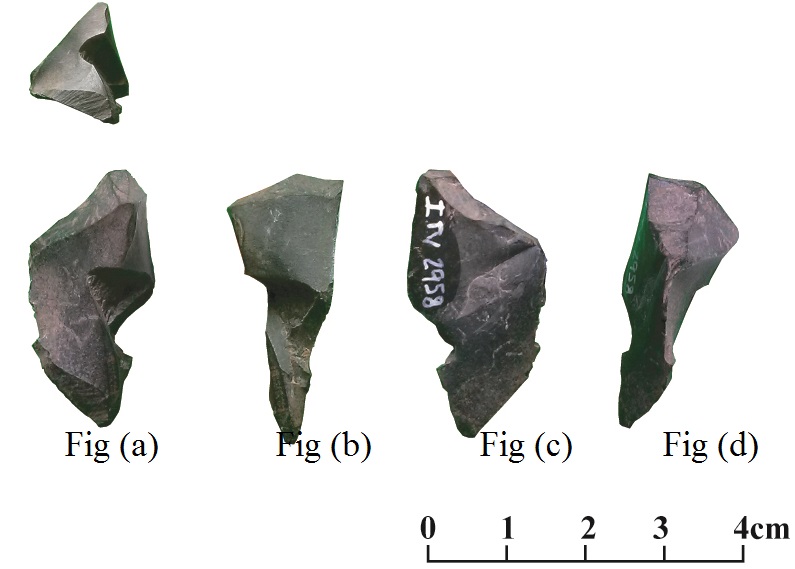Short lithic reduction in the Itapeva refuge, São Paulo, Brazil
Main Article Content
Abstract
The lithic industry of the Itapeva refuge, located southeast of SP, Brazil, was examined. The physical and technical attributes were checked on 3,168 pieces with the aim of creating groupings and statistically verifying their relevance from the point of view of the intersection between them. The study focuses on knapping and the quality of the raw material to determine the supposed little technical transformation of the lithic supports used. The conclusion is that there are knapping processes that can be detected through statistical analyzes of knapping sequences considered short and random, suggesting the hypothesis that lithic industries called expedients have standardized reduction that are connected to a series of knapping methods in raw materials of variable quality, with no drop in technical execution based on random knapping.
Downloads
Article Details

This work is licensed under a Creative Commons Attribution-ShareAlike 4.0 International License.
COPYLEFT
This work is licensed under a Creative Commons Attribution-Share Alike 4.0 International License.
COPYRIGTH
The copyright and copyrights of the articles are held by the authors themselves.
This will be indicated in each article, as well as the Copyleft license described above.
How to Cite
References
Binford, L. R.
1966.A preliminary analysis of functional variability in the Mousterian of Levallois facies. American Anthropologist. 68 (2):238-295. DOI: 10.1525/aa.1966.68.2.02a001030
Bordes, F.
1961 Typologie du Paleolithique ancient moyen. Bordeus, Imprimieres Delmas.
Crabtree, D. E.
1968. Mesoamerican polyhedral cores and prismatic blades. American Antiquity, 33(4): 446-478. DOI: https://doi.org/10.2307/278596
Dutra, R; M, Sperandio; J. Coelho.
2004 O Método Ward de Agrupamento de Dados e sua Aplicação em Associação com os mapas Auto-Organizáveis de Kohonen. In: WorkComp-Sul. Florianopolis.
Garcia, F. L. M. R.
2015 Análise de componentes principais e escalonamento multidimensional: duas classes de métodos multivariados de redução de dimensionalidade. Monografia, Universidade Federal do Rio de Janeiro.
Gero, J.
1983 Stone tool in ceramic contexts: Exploring the unstructured. Investigation of the Andean past: Papers from the first Annual Northeest conference on Andean Archaeology and Ethnohistory (ed. D. H. Sandweiss), pp. 38-50. New York.
Kaushik, M and B. Mathur.
2014 Comparative Study of K-Means and Hierarchical Clustering Techniques. International Journal of Software & Hardware Research in Engineering. 2(6):93-98.
Laming-Emperaire, A; M.J. Menezes; M.D.Andreatta.
1978 O trabalho de pedra entre os Xetá da Serra dos Dourados, Estado do Paraná. Coleção Museu Paulista: serie ensaios, 2:19-82.
Linden, R.
2009 Tutorial: Técnicas de Agrupamento. Revista de Sistemas de Informação da FSMA, 4:18-36.
Lycett, S and C. Norton.
2010 A demographic model for Paleolithic technological evolution. The case of East Asia and movius line. Quaternary International. 211(1-2):55-65. https://doi.org/10.1016/j.quaint.2008.12.001
Merencio, F.T
2014 Tecnologia lítica Xetá: Um olhar arqueológico para a coleção etnográfica de lítico lascado e polido do MAE-UFPR. Dissertação de mestrado. Universidade Federal do Paraná.
Miller Jr., T.O.
2009 Onde estão as lascas? Clio arqueológica. 21(2):6-66.
MILLER JR., T. O.
1979 Stone work of the Xetá Indians of Brazil. Lithic Use-wear Analysis. (ed. B.HAYDEN, B.). pp. 401-407, New York
Mijares. A.
2001 An expedient lithic technology in northern Luzon (Phillippines). Lithic Technology, 26(2):138-152.
Nash, S. E.
1996 Is curation a useful heuristic? Stone tool. Theoretical insights into human prehistory. (ed. G.H. Odell), pp. 81-99, New York.
Nelson, M. C.
1991 The study of technological organization. Archaeological Method and Theory, 3:57-100.
Odell, G. H.
2001 Stone tool research at the end of the millennium: classification, function and behavior. Journal of Archaeological researcher. 9(1):45-100. DOI: 10.1023/A:1009445104085
Parry, W and R. Kelly.
1987 Expedient core technology and sedentism. The Organization of Core Technology. (ed. J, K, Johnson; C.A, Morrow). pp. 285-304, Boulder, CO.
Stasinopoulos. D and M. R. Rigby.
2007 Generalized Additive Models for Location Scale and Shape (GAMLSS). Journal of Statistical Software. 23(7):1-46. DOI: 10.18637/jss.v023.i07
Steinbach M; G. Karypis; V. Kumar.
2000 A Comparison of Document Clustering Techniques. KDD-2000 Workshop on Text Mining. 400(1):525-526.
Vaquero, M and F. Romagnoli.
2018 Searching for lazy people the significance of expedient behavior in the interpretation of Paleolithic assemblages. Journal Archaeological Method Theory. 25:334-367. DOI: 10.1007/s10816-017-9339-x




